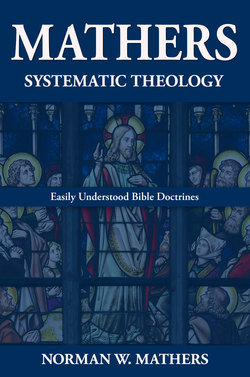Читать книгу Mathers Systematic Theology - Norman W. Mathers - Страница 16
На сайте Литреса книга снята с продажи.
2.2.2 The Canonicity of the Scriptures
ОглавлениеThe definition of canon means a standard or rule by which the book was measured. The early church recognized the authority of the New Testament. It did not give any authority to the Bible. The authority of the Bible is the Bible’s testimony to itself (Shedd 1979:1:142). The Scriptures claim to be God breathed. They were written by men chosen by the Holy Spirit (2 Pet. 1:20-21). There is a dual authorship behind the scriptures. Christ charged the scribes with the blood of all the prophets from Abel to Zacharias. This reference is found in Luke 11:51. This covers the entire Old Testament canon from Genesis to the last book of the Hebrew Old Testament which is 2 Chronicles (Ryrie 1974:45). The discovery of the Old Testament Dead Sea Scrolls in 1947 gave us an account of the Old Testament books which is a 1000 years earlier than the previous copies which was A.D. 895. (ibid:45). The Old Testament books were written on scrolls from Moses in the fifteenth century B.C. to Malachi in the fifth century B.C. (ibid:45). The Dead Sea Scrolls gave us the Hebrew Old Testament at the time of the second or first century B.C. (ibid:45). The one exception was the book of Esther (ibid:45). The Masoretes had added the vowel pointings to the Hebrew Bible at A.D. 900. The Hebrew Old Testament had been translated into the Greek language in B.C. 250. This translation is known as the Greek Septuagint (ibid:46). The Council of Jamnia in A.D. 90 recognized the authority of the Old Testament scriptures. The Council of Carthage in A.D. 397 recognized the authority of the 27 books of the New Testament (Lightner 1972). The scriptures are authoritative because of the testimony of the Lord Jesus Christ. The scriptures are witnessed to by the Prophets. The Holy Spirit testifies that the scriptures are the Word of God (Eph. 6:17, 1 Tim. 4:1). The power of the Word of God testifies to both its authority and power to be obeyed (Chafer 1971:1:89-104). Hodge (1975:1:152-153) argued that only the Old Testament books which Christ and his apostles recognized as the Word of God are to be part of the canon. They testified to the authority of the Old Testament books to be the Word of God. In the case of the New Testament, only those books proven to be written by apostles or having apostolic approval are recognized as having divine authority. They are the Word of God. The apostles were appointed by Christ. It must be underscored that the early church did not lend any authority to the Old and New Testaments. They recognized the authority of each of the 66 books of the Bible. Hebrews, James, Jude were slower to be added to the canon than others (Warfield 1948:415). Other books which were not readily accepted until later were 2 Peter, 2nd and 3rd John (Ryrie 1974:44). This points to the fallibility of the early church to recognize parts of the Bible to be the Word of God (Warfield 1948:416). These books had to be written by a prophet, a recognized leader in Israel or an apostle or someone who wrote under the supervision of an apostle. An example of this would be the Gospel of Mark who wrote his gospel under the supervision of Peter. Luke wrote his gospel and the book of Acts under the supervision of Paul (Ryrie 1974:43). The reader should check 1 Peter 5:13 and 2 Timothy 4:11. Warfield (1948:411) based his argument for New Testament canonicity on whether the book of the Old or New Testament was written by a prophet or an apostle. The apostles recognized the authority of the Old Testament. Paul quotes both Deuteronomy and Luke in 1 Timothy 5:18 calling them both scripture. The authenticity of the writer was recognized not only by the church but by scholars throughout the ages. The testimony of the books of the Bible claiming to be the Word of God (ibid:412). The Bible book claims to be authoritative (Ryrie 1974:43). The contents of the New Testament books must be consistent with other scripture. There must not be contradictions or other problems in the book. The book had to have a life changing power (Lightner 1972). The New Testament recognized the Old Testament as scripture (2 Tim. 3:14-17, 2 Pet. 1:20-21). The canon of our Lord Jesus Christ had a three fold division of Law, the Prophets, and the Writings (Luke 24:44). These are the major arguments for canonicity. They are the Bible’s testimony to itself and the early church recognized that authority. The Bible book had to be written by a recognized leader, prophet, or apostle or under the supervision of an apostle, content must be consistent with the rest of scripture, and the book had to have a life changing power. Secular historical books (Caesar’s Gallic War, Livy, Tacitus, Thucydides, Herodotus) are accepted upon much less manuscript evidence than the wealth of New Testament manuscripts which exceeds 5,000 in number (Bruce 1943:16-17 in Ryrie 1974:46-47). These are not complete manuscripts. Seventy five papyri date from the second century A.D. (ibid:47).
